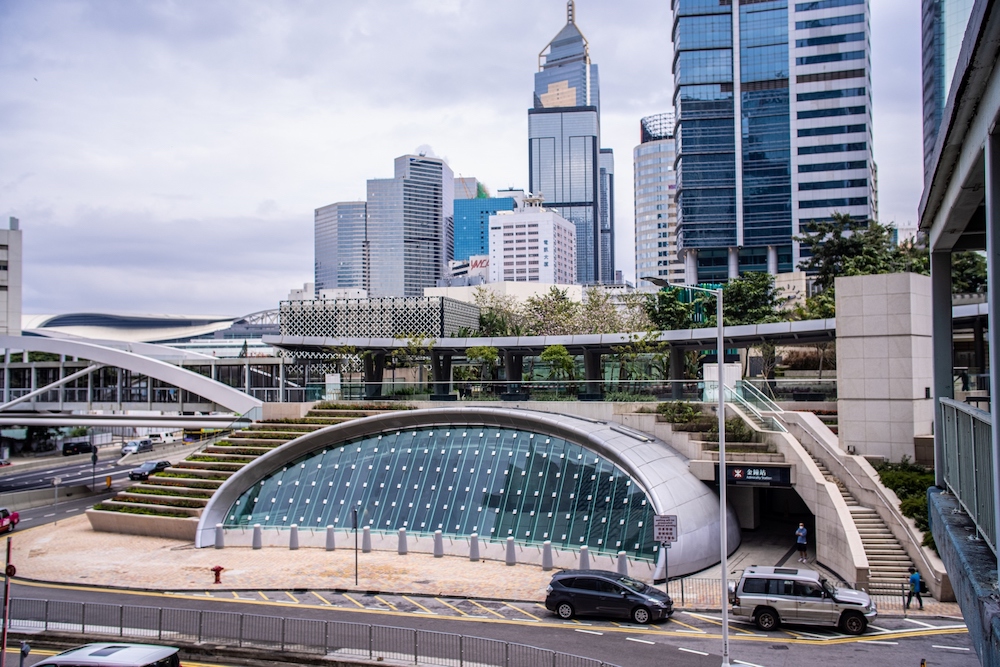A couple of thousand years ago, a Greek mathematician named Euclid refined the basic ideas of geometry. Although many of us tossed aside our maths schoolbooks the first moment we could, perhaps we should have saved them, because the basic principles Euclid outlined about the relationship between lines, angles, surfaces and solids are vital to the measuring and ordering of space, which remains one of the cornerstones of event planning.
Of course, that’s not to suggest that event planners need to haul along their measuring tapes and spirit levels to every event, but simply that creative approaches to the use of space ultimately depend every bit as much on science as they do on art. Getting the most from an event is all about bringing various elements into harmony, not just the physical space but also lighting, sound, colour and that most variable of variables, human beings.

Space and harmony
The Chinese, of course, have developed a small industry to achieve this harmony. Feng shui, literally “wind-water” in English, bases its principles on how energy is channelled in particular positive or negative directions by building locations, furniture alignment and window angles to create an aura of prosperity and health. Many hotels in Asia incorporate elements of feng shui in their design. At The Ritz-Carlton, Millenia Singapore, for example, the windows in the rooms and bathrooms are octagonal in shape, helping to “create positive qi”.
Too often, people think of space as simply empty nothingness. A truly creative event planner, on the contrary, sees space as a blank canvas, just waiting to be sketched and coloured. Take sound, for example: experts often talk of the importance of “acoustic space”. Sound waves bounce in all directions – off walls, ceilings, floors and windows. Depending on the structure of the room and the objects in it, sound is either absorbed, reflected or diffracted as it travels through space. Poor venue choice or thoughtless event design can ruin even the greatest orator’s presentation, so don’t just blame bad sound on the microphone or the sound engineer.
Light, just like sound, travels in waves and is similarly reflected and absorbed as it travels through space. Altering lighting not only shifts the mood, it can change our perceptions of the shape and depth of a room – an insight television and movie studios have been using for years.
For example, natural light will always make any space look larger, especially if the windows are floor to ceiling. Be careful though about glare – you don’t want delegates blinded by harsh sunlight or unable to read from screens. Failing that, skilful use of artificial lighting will also enhance the size of a meeting or function room. Bright colours, especially creams and blues, can give the feeling of enlarged space, while, subdued lighting and warm, darker colours give larger rooms more intimacy and cosiness.
Christiane Kasper, senior manager for marketing communications, Singapore EXPO and MAX Atria @ Singapore Expo, adds this piece of advice: “Small venues can easily appear larger by predominantly avoiding horizontal décor, while focusing on longer and taller furniture, as well as keeping décor to a minimum to avoid clutter.”
She also notes that placing mirrors on walls gives the illusion of a more spacious room. “Space can also be planned well by keeping seating arrangements simple and avoiding elaborate furnishings.” These simple solutions can be implemented by the venue itself or by a skilled event design team for very little outlay. Jill Henry, former chief executive of the Sarawak Convention Bureau and currently director of Business Events Freedom Films in Perth, Australia, notes: “The style and layout of rooms for conventions is changing. In terms of the creative use of space. Personally, I love the modern technology that enables clever use of lighting and projection to change the perception of the size of the area in use. At Sarawak, we did an ‘under the sea’ theme in the convention centre great hall which used projections of underwater images to create the illusion of dining underwater.”

Measure for measure
Space costs money, so carefully estimate how much space you require. Do you really need 20 breakout rooms for three full days or is it more sensible to reorder the conference agenda? Kasper says: “Depending on the requirements and the nature of events, the formula for space might vary. However, as a general rule of thumb, a one square metre per person formula applies at the start of preparation in the set-up of the event.”
There are three simple rules to follow. Every delegate should have:
• A clear view of the screen or speaker
• Easy access to their seat
• Sufficient elbow room
There’s no single magic formula for working out the space you will need but the Marriott International hotel group, for one, does provide a simple calculator tool (see box below). Here, you can input your number of attendees and see how much space you will need for particular set-ups. Alternatively it allows you to enter the floorspace you have and each set-up will show recommended numbers.
While this is extremely helpful as a general guide, there is simply no substitute for site inspections. Here, you might discover that the hotel’s super-large ballroom on the layout plans actually has half a dozen unsightly pillars, or that the boardroom’s wonderful mahogany table is so large that attendees can barely squeeze into their seats. It’s also a good idea to check that there are sufficient entrances and exits serving your chosen space, to avoid frustrating bottlenecks on arrival and departure. Site inspections are essential when dealing with unusual or unique venues since most purpose-built hotel or convention centre venues follow fairly modular arrangements, while an art gallery or museum’s layout by contrast will be built around quite different spatial concepts.
But the results can be spectacular. Henry vividly remembers one special venue she used: “I once did a dinner for 10 VIP clients in a sports arena that seats 10,000. The dining table was set up in the centre of the arena on a shag pile carpet with a family dining suite set for fine dining. On arrival the arena was totally dark with just a downlight spot on the dressed table. The participants arrived on Harley-Davidson motorcycles and were blindfolded so they didn’t know which venue they were going to eat at. They were driven right up to the table. The evening felt very intimate most of the time but spectacular entertainment effects were used by lighting selected areas for showpieces such as a lone piper, motorcycle stunt display and other cameos. That’s great use of a space which was able to be transformed from intimate to mega in a flash.”
Once your space is chosen, you then need to decide how to utilise it most effectively. Mix has compiled a chart of the seven most popular configurations that have evolved over the years.
Outdoor options
Of course, venues don’t all have to be indoors. There are good reasons to look at holding part of your event outside, whether it’s a barbecue dinner on the beach or a drinks reception on the hotel grounds. Delegates are often thankful to leave the cloistered conference room and enjoy some fresh air. There are good environmental arguments too for leaving behind the air-conditioners and artificially lit meeting rooms.
The key rule is always to have a Plan B – most venues will build this into your plans but inevitably this comes at a price, and you will end up allocating some of your budget to reserve indoor areas you hopefully won’t need. This is the one time when it is advisable to book more space than you actually require.
One further factor to take into consideration is that people need to move as freely as possible within the space you have hired. That means not only paying attention to the flow of human traffic in and out of the venue, but also ensuring easy access to washrooms and designated smoking areas. In addition, whether or not it is a legal requirement you should certainly consider accessibility for any delegates who are disabled or who have mobility problems. Is your chosen space surrounded by steps and stairs or does it have elevators and ramps? Remember too that some outdoor venues need special permits and licences.
Whether it’s a small intimate gathering of top executives or a mass rally of worldwide salespeople, choosing and using your space wisely is critical to the success of every event you will ever organise.
HOW MUCH SPACE DO YOU NEED?
Number of delegates: 100
| Configuration | Square Feet | Square Metres |
| Theatre style | 950 | 88 |
| Reception | 1,450 | 135 |
| Banquet style | 1,250 | 116 |
| Conference style | 4,010 | 373 |
NB: These are estimates only!
Add 20% for rear screen AV
Add 10% for stage or head table
Add for obstructed space
Source: www.marriott.com/meetings/tools/space-session.mi
TIPS FOR THE GREAT OUTDOORS
• Always have an indoor venue backup in case of sudden weather shifts.
• If there are speakers or entertainment make sure the sound system is strong enough to be heard but not too powerful to disturb neighbours/wildlife.
• Where possible allow delegates time to change into something more comfortable.
• Outdoor catering has special challenges so adhere strictly to hygiene rules.
• Check if the outdoor space has a bug or mosquito problem, or if it is close to an airport’s flight path – airborne pests come in different shapes and sizes!
• Respect the environment – ensure a swift clean-up afterwards.
MAKING SPACE
|
THEATRE STYLE |
CLASSROOM STYLE |
BANQUET STYLE |
CRESCENT STYLE |
CONFERENCE STYLE |
U-SHAPE |
HOLLOW RECTANGLE |
|
| DESCRIPTION | Chairs are lined up in rows either straight, semicircular or herringbone, facing the speaker. It’s best to offset each row so that delegates do not sit directly behind one another | Long, narrow tables are positioned in front of rows of chairs facing the speaker.
|
Guests are seated at round tables usually seating 10-12 people each. | Attendees are seated at round tables but without the three or four chairs in which delegates would have their backs to the speaker, thus forming a “crescent” facing the speaker. | Delegates are seated on all four sides of a table or group of tables set out in a rectangular shape. | Tables are positioned to form a “U”. Seating is usually on the outside of the U, but it’s possible to seat delegates on the inside legs of the U. | Classroom tables are arranged in a square or other multi-sided design in which the centre is left empty. |
| BEST FOR | Listening to a speaker or watching a presentation. | When a presenter does most of the talking and delegates must take written notes, input notes on laptops or refer to material. | Meal functions, such as networking lunches and gala dinners. | A room that is used for both meals and an educational session immediately following. | Board and committee meetings and other smaller functions at which interaction between participants is expected. | Board of directors and committee meetings. Breakout sessions involving audio-visual presentations with the screen placed at the open end of the U. | Larger committee or board meetings of 17 to 30 people, at which interaction among attendees is important. |
| PROS | Maximises seating capacity. | Comfortable for long sessions. | Also good for small round-table meetings and breakout sessions. | Also appropriate for general sessions where attendees break into small groups in the same room. | Design can also be used for high-level dining functions with a small number of guests. | Can be used for banquets, with seating on all sides of the U. | Octagons and hexagons work well to improve sightlines among attendees. |
| CONS | Not recommended for note-taking sessions. | Doesn't encourage interaction among attendees. | If there are speakers or entertainers, half the audience must turn around or crick their neck to see the stage. | No change of scene between meal and session for delegates. | Only works with limited number of participants. | Only works with limited number of participants. | Limited number of participants. Need to avoid long straight sections of tables. |
Toni Palmiro


